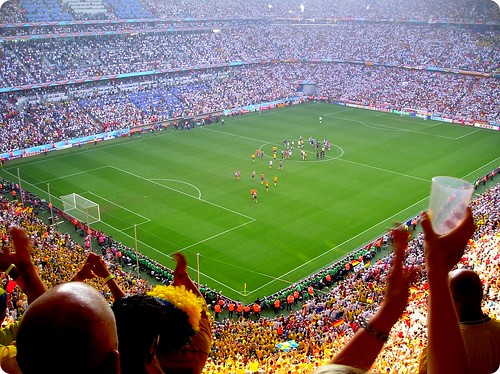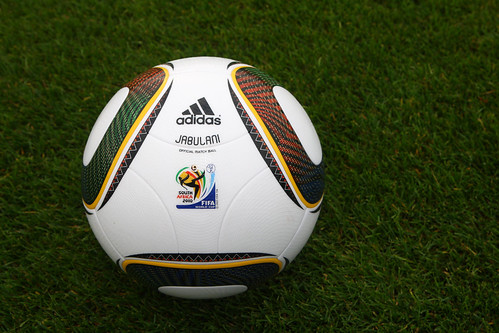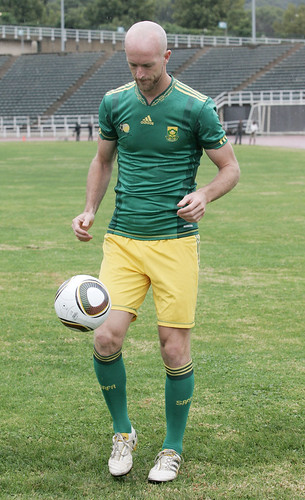By Gina Williams
[Gina is a blogger for the AutonomieProject. Orginally published on the AutonomieProject]

As far back as my brain can remember, I patiently wait every four years for the magical, exhilarating and largest sporting event on the planet: THE WORLD CUP! I was raised in a football, ah well since this is the States I will say soccer, family. As a family we ate, breathed, and drank soccer. Myself, siblings, father, and mother all have played, refereed, and coached soccer through the years. I can remember where I watched every World Cup Final game for the last 22 years or so! Perhaps my favorite memory, is driving home from Oregon to California and stopping in a furniture store with my Dad to watch Brazil and France duke it out in 1998.
Click HERE for PLANET GREEN's Top 5 Eco Athletes
Anyway, I am not alone in this sheer excitement and anticipation, as most of the world, sans the majority of the US, will be glued to any television available to catch all the matches in this year’s cup. That is right, 2010 is a World Cup Year and I am counting down the days( I have even downloaded the World Cup Countdown App to be sure I keep on track)!

From CNN: Others believe the World Cup is a lost opportunity for South Africa to be a world leader in making sport greener.
"I think South Africa has missed a trick in not seeking, of its own volition, to host the first 'carbon neutral' mega-event," Anton Cartwright, co-founder of Promoting Access to Carbon Equity told CNN.
Read More On CNN...
Ok so now you are probably wondering, why on Earth would Autonomie Project, a Fair Trade and Eco friendly Fashion company be discussing a sporting event? Well, not only am I a HUGE fan of the sport, but we recently were made aware of some interesting details. This year’s cup is hosted by South Africa and preparations for the tournament began long ago. Like many modern events, a focus on making the event carbon neutral was an early goal for South Africa. However, with a mass frenzy to build the infrastructure for the World Cup, there seems to be a bit of greenwashing going on.

It is true that South Africa has made serious efforts to keep the games Green, such as their carbon offset program, where they have planted over 800,000 trees in various cities. Many South African environmentalists aren’t quite buying it though. Bobby Peek of Friends of the Earth South Africa reiterated this point, “Once carbon is produced, claiming that offsetting is ‘neutralizing’ the carbon footprint is nothing more than ‘greenwash.’” We somewhat agree with this idea, however, planting trees is always a great improvement for a city. On top of carbon offsetting, South Africa has improved its public transportation for the event, making it easy and efficient to travel between stadiums.

When preparations first began, the country was toting itself as creating a Green World Cup. Environmentalists inside the country were frustrated when a new stadium was built, rather than using the old stadiums in Durban. Many were outraged that new construction materials were adding to the overall carbon footprint of the tournament. This definitely may be true, however construction on the new stadium is very eco-friendly. Not only did they re-use much of the concrete and o ther building materials from the demolished stadium, but the new stadium is also built with PTFE which provides natural light, has natural ventilation, energy efficient heat, and collects rainwater. Even though we agree that keeping the old stadium would in large be more eco-friendly, at least the new stadium was built with some re-used materials and with green architecture in mind.

Beyond the country of South Africa, this year’s “World Cup 2010 Kits,” created by Nike, are claiming to be the most Environmentally friendly kits ever. The jerseys to be worn by the most famous players such as Ronaldo, and by the average soccer fans at home, are made from recycled plastic bottles. They say that they used enough plastic bottles to line the whole coast of South Africa into the uniforms. A Nike spokesperson told GreenMyStyle.com the kits are sustainable in other ways, “We use a variety of environmentally preferred materials such as PET, organic cotton, ‘green’ rubber, and many of our inputs into our shoes are recycled materials from factory production.” This sounds all well and good, however, GreenMyStyle and others are questioning Nike’s credentials, as they haven’t always been the most ethical company in the past and do not provide transparency into where the materials actually come from or provide certification. Also, recycling is great but probably not the most sustainable method of production, as the process itself emits pollution. On another note, Nike has been the subject of labor rights issues, with sharp criticism from both the Fair Trade and Labor Rights movements.

Although, it seems serious steps are being made by the South African government and World Cup planners, as well as private industry to make the 2010 World Cup Green, there is still disappointment. It was reported that the 2010 World Cup has a carbon footprint 6 times larger than the 2006 World Cup, held in Germany. It should be noted the 2006 numbers did not include transportation and most qualifying teams are from Europe, cutting down the impact of distance traveling. It seems most environmentalists feel South Africa dropped the ball on making the event green and think bigger steps should have been made. However, there are a couple of great things that will come from this including more efficient public transportation, more green space, drawing attention to the environmental sector in the country, and encourage the next World Cup (held in Brazil) to go even more Green!
While knowing that the biggest way the World Cup could cut their carbon footprint is to lessen world travel, it sort of defeats the heart of the cup. Much like the Olympics, the World Cup is seen as a time for harmony and for the world to come together. There may come a time when the matches may need to be played in a more central location and possibly only the finals in distant lands. Whatever the future holds the environmentalist in me is happy to see some changes and is hoping for more, but the soccer lover in me is anxiously awaiting June 11th. In fact, as we speak my World Cup Countdown App says we have 7 days, 21 hours, 44 minutes, and 41, 40, 39, 38 seconds…
Follow Us On Twitter@GreeningHollywd
Facebook/GreenBlogNetwork
Posted via web from The Green Blog Network
 California Governor Arnold Schwarzenegger and Congressman Henry Waxman (D-California) in Washington D.C. June 10, 2010.
California Governor Arnold Schwarzenegger and Congressman Henry Waxman (D-California) in Washington D.C. June 10, 2010. 

















